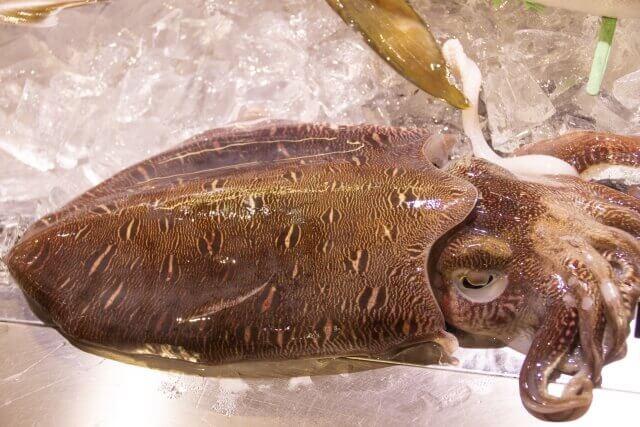 No people in the world love squid more than the Japanese. Squid ranks third in import volume behind shrimp and tuna. Squid is brought to Japan from the oceans all over the world. There are between 400 and 500 species of wild squid on Earth. Some, like the pygmy cuttlefish, are tinier than 3 millimeters while the giant squid is over 10 meters.
No people in the world love squid more than the Japanese. Squid ranks third in import volume behind shrimp and tuna. Squid is brought to Japan from the oceans all over the world. There are between 400 and 500 species of wild squid on Earth. Some, like the pygmy cuttlefish, are tinier than 3 millimeters while the giant squid is over 10 meters.
There are about 100 species of squid that live in the waters surrounding Japan. Surume ika (Japanese common squid) makes up the highest volume of domestic-caught squid. It is used as a Yari ika or Surume ika topping in eastern Japan, but Surume ika isn’t used very often in western Japan. At sushi restaurants, squid like Sumi ika (Golden cuttlefish), Aori ika (Bigfin reef squid), Kensaki ika (Swordtip squid) and Mongou ika (Ocellated cuttlefish) go for high prices, but they are all caught in smaller quantities and therefore only available to high-end sushi restaurants that can procure them fresh.
There are some conveyor belt sushi restaurants that list Mongou ika (モンゴウイカ又はカミナリイカ) on the menu, but actually serve European common cuttlefish. It is produced in the waters off the coast of West Africa. Even some sushi restaurants do this. This is actually still too pricey for conveyor belt sushi though. What is generally used at conveyor belt sushi is Flying squid, which goes for only 1/10 the price of the European common cuttlefish and reaches 60 cm in length. Jumbo flying squid is also often used. The Jumbo flying squid is more than twice as long as the Flying squid and exceeds 1 meter in length. The Jumbo flying squid is mainly imported from places on the other side of the world such as Chile and Mexico. The thickness of the meat is similar to Mongou ika. However, a big drawback is that the Jumbo flying squid lacks the sweetness peculiar to squid. Therefore, it is soaked in water that has been artificially sweetened. This alters the dried out sensation to a plump, moist sensation, making the customer believe it is Mongou ika.
The squid must have a certain thickness in order to masquerade as Mongou ika. Rhomboid squid, which has a torso length of 80 cm is also disguised as Mongou ika. Rhomboid squid is found in the warm waters of the world and is even caught in relatively high volume in Japan. Large squid have a low price cost, so it’s good for the shops to make a profit. Furthermore, the sweetness is brought out more when frozen first than by serving it fresh. That means it can be used as Mongou ika without any need for the artificial sweeteners used in Flying squid and Jumbo flying squid.
The fact is that there are many substitute products for Mongou ika. But even so, it doesn’t change the fact that using ingredients disguised as others is an unacceptable practice.
Types of substitutes for the Mongou ika
European common cuttlefish: Sepia officinalis (Linnaeus, 1758)
European common cuttlefish (ヨーロッパコウイカ) is found from the Atlantic coast of France to the Mediterranean and west coast of Africa. It is often caught in the waters around Morocco. Its body length is around 30 cm. When it first arrived on the Japanese market, it was called Mongouika, hence the name.
The scientific name sepia means black pigment and officinalis means medicinal, indicating that this is a material for Chinese herbal medicine. At processing plants in Thailand and China, the fish is made into fillets for sashimi, and then vacuum-packed and sent to Japan.
Flying squid: Ommastrephes bartramii (Lesueur, 1821)
Flying squid (アカイカ) is distributed in the North Pacific, South Pacific, and Atlantic Oceans. Its body length exceeds 40 cm, and it can weigh more than 4 kg. It is similar in appearance to the Surumeika, but has a darker, blackish back. It is used as a substitute for Surumeika for processing such as delicacies.
Jumbo flying squid: Dosidicus gigas (Orbigny, 1835)
Jumbo flying squid (アメリカオオアカイカ) is found only off the Pacific coast of the United States, Chile and Peru in South America. They are over 80 cm in length, weigh around 10 kg, and have as many as 100 to 200 suckers. In Peru, they are called Pota. Japanese fishing vessels used to catch flying squid mainly in the North Pacific, but their catch has drastically decreased due to the ban on drift net fishing.
Japanese vessels have switched to fishing for Jumbo flying squid, a member of the flying squid family, in the waters off Peru and other areas. Fishing for Jumbo flying squid in Peruvian waters continues from spring to fall.
Since the drifting net fishing of flying squid has been banned, it is the most promising resource as a raw material for processing. However, the larger ones store ammonia in their muscles, so de-ammonia treatment is required when processing them.
Rhomboid squid: Thysanoteuthis rhombus Troschel, 1857
Rhomboid squid (ソデイカ) is widely distributed in the warm waters of the Pacific and Atlantic Oceans. The body length is 70 cm. Its fins are diamond-shaped and the same length as its body. Because they do not form large schools and live scattered, they have been a difficult resource to exploit.
After a new fishing method was developed in the Tajima region of Hyogo Prefecture in the 1960s, the fishery began in earnest. Because of its reasonable price, it is often used in restaurants such as conveyor belt sushi restaurants. Also called Diamond squid or Diamondback squid.
[sc_apply url=”https://sushiuniversity.jp/apply/”]
We hope this information will be helpful.

Revision date: March 24, 2023
Share this article